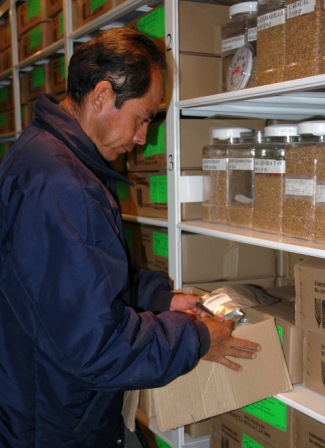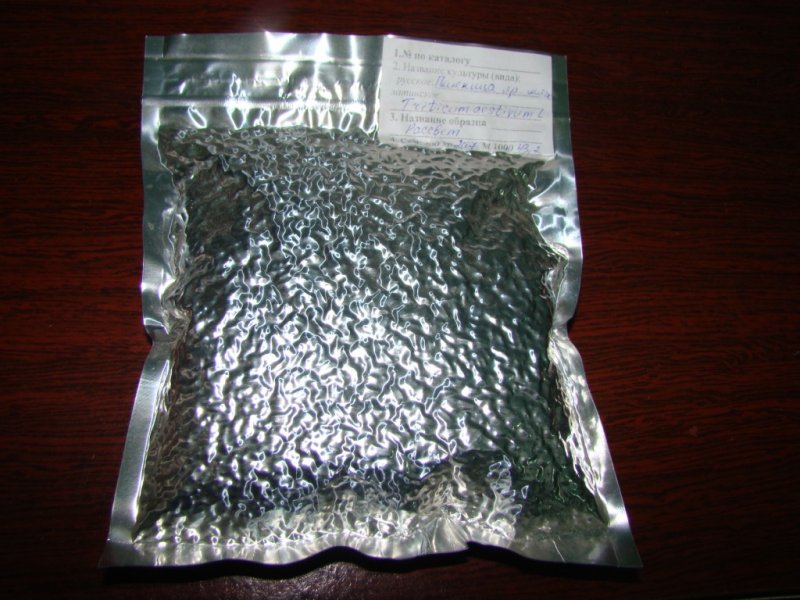Storage of bread wheat, durum wheat, triticale and related cereals
Contributors to this page: CIMMYT - Wheat, Mexico (Thomas Payne), ICARDA, Syria (Ahmed Amri) with inputs also received from CIMMYT - Maize, Mexico (Suketoshi Taba), USDA - National Small Grains Collection, Aberdeen, Idaho (Harold Bockelmann), CGN, Wageningen, The Netherlands (website) and IPK, Gatersleben, Germany (Helmut Knűpffer).
|
Contents: |
 |
|
|
Cold and dry storage rooms for conservation of seed. Notice the warm clothes of the genebank staff (photos: CIMMYT) |
|
Definition
The base collection is a long-term storage facility. The initially collected seed accession sample is used as a bench mark for monitoring changes in the genetic identity and diversity of the accession, over time and after cycles of regeneration, that may arise due to genetic drift. The facility should insure that an accession’s seed viability remains at acceptable levels for at least 50 years, or at least one cycle of the regeneration of the accession.
When should base collection samples be used
- To hold seed samples for long-term conservation.
- To serve as a duplicate, safety collection of the active collection and for long-term conservation.
- To reduce the number of regeneration cycles, thereby better maintaining the genetic integrity of the accessions.
- To provide foundation seeds for regeneration of the genebank accessions.
- To provide seed samples of accessions requested for exchange with other genebanks.
- When blackbox sets are prepared for safety duplication deposit at other cooperative genebanks.
- Its function and operation should be supported by long-term institutional funding.
Sample specifications
Minimum sample size for storage
A representative sample should be used to avoid genetic drift. There are a few options that could be chosen:
- For cultivated cereals: two packets of 25 g each; for wild cereal species: one packet of 25 g (as followed at ICARDA).
- For wheat in general use 100 g, equivalent to about 3000 seeds (as followed at CIMMYT).
Minimum viability for storage
- For cultivated cereals: > 90%; for wild cereal species: > 80% (as followed at ICARDA).
- For wheat in general use >85% (as followed at CIMMYT).
Moisture content
To avoid any deterioration to the stored seed samples.
- 5-7% seed moisture content (as used at ICARDA).
- Or 3-5% seed moisture content (as used at CIMMYT).
Container specifications
Seed packaging method
- Use aluminum foil packets sealed hermetically under vacuum with a heat sealer.
- The packets should be re-sealable and impermeable to air and moisture.
- Packing is best carried out in an air-conditioned room with controlled humidity, as quickly as possible after drying.
Specifications of packaging material
-
Three-ply aluminum foil bags should be used comprising:
- An inner layer of polyethylene, needed for sealing.
- An intermediate layer of aluminum foil, which prevents moisture penetration.
- An outer layer of polyester providing mechanical strength.
Storage specifications
Assigning location codes
For easy access and location of the accessions.
- The seed accessions should be stored in an orderly fashion.
- A standard nomenclature for shelf location within a collection should be used allowing each accession in the collection to be quickly located. Use coordinates such as unit/block/cart number, row shelf number, shelf number, and tray/box number, packet number.
Storage conditions
Low temperatures and seed moisture content are important to maintain seed viability.
- -18 to -22oC.
Recording information during storage – Base collection
The following information should be recorded for each step:
- Accession number (unique number).
- Weight of the sample (g).
- Estimated number of seeds (estimated from 1000 kernel weight).
- Year of regeneration (date).
- Viability (%).
- Viability test date (date).
- Recommended next viability test date (date).
- Phytosanitary status (approved, conditionally approved, rejected).
- Position of the sample in the storage facility (coordinates).
Definition
The active collection consists of accessions that are designated as available for distribution and hence are accessed more frequently than those in the base collection. The active collection is intended to preserve germplasm viability in medium-term storage conditions for at least 20 years or for half of one regeneration cycle in the base collection.
When should active collection samples be used
- The active collection should be used to hold seed samples for mid-term conservation.
-
Accession samples from the active collection are used to:
- Conserve those accessions that are most actively used, or those that are expected to be used, such as elite lines and populations, core subsets and reference seeds sets.
- Distribute seed samples requested by clients.
- Store introductions and the regenerated seeds prior to processing and formally inventorying them into the base and active collections.
Sample specifications
Minimum sample size
- For cultivated cereals: 1500 seeds; for wild cereal species: 1500 seeds (as used in ICARDA).
- Or 250 g (about 7000 seeds), as used in CIMMYT.
Viability for storage
- For cultivated cereals: > 90%; for wild cereal species: > 80% (as used in ICARDA).
- Or >85% (as used in CIMMYT).
Moisture content
To avoid any deterioration to the stored seed samples.
- 5-7% seed moisture content (as used in ICARDA).
- 3-5% seed moisture content (as used in CIMMYT).
Container specifications
Seed packaging method
- Hermetically sealed and re-sealable containers.
Specifications of packaging material
The packaging material must be moisture resistant and withstand storage at low temperature for long periods of time without cracking or any other physical deterioration.
-
Some collections prefer to use three-ply aluminum foil bags comprising:

Wheat seeds in vacuum packed alluminium bags (photo: Bioversity/ILRI by kind permission of Belarus genebank)
- An inner layer of polyethylene, needed for sealing.
- An intermediate layer of aluminum foil, which prevents moisture penetration.
- An outer layer of polyester providing mechanical strength.
- Other collections prefer the easier access of square-based bottles with a screw cap made of pure, high quality, plastic materials, that are semi transparent or white in colour, with a volume of 400 ml, or clear glass jars.
Storage specifications
For easy access and location of the accessions.
Assigning location codes
- The seed accessions should be stored in an orderly fashion.
- A standard nomenclature for shelf location within a collection should be used allowing each accession in the collection to be quickly located. Use coordinates such as unit/block/cart number, row shelf number, shelf number, and tray/box number, packet number.
Storage conditions
The temperature can be between 0oC and 10oC with a relative humidity (RH) of 25% to 35% to ensure the seed viability for more than 20 years. Low relative humidity in the storage room is more important to the seed longevity than low temperature.
- 3 ± 2oC (as used in ICARDA - it extends storage life and breaks any seed dormancy that may exist).
- 0oC (as used in CIMMYT).
Recording information during storage – Active collection
The following information should be recorded for each step:
- Accession number (unique number).
- Weight of the sample (g).
- Estimated number of seeds (estimated from 1000 kernel weight).
- Number of 'user packets' (if applicable) (number).
- Year of regeneration (date).
- Viability (%).
- Viability test date (date).
- Recommended next viability test date (date).
- Phytosanitary status (approved, conditionally approved, rejected).
- Position of the sample in the storage (coordinates).
- Flag indicating distribution status.
Storage space arrangement
It is very important to permit easy access to the accessions.
- Minimum space should be used to maximize packing efficiency, while allowing convenient access to each sample.
- A standard nomenclature for shelf location within a collection should be used allowing each accession in the collection to be quickly located. Use coordinates such as unit/block/cart number, row shelf number, shelf number, and tray/box number, packet number.
- Movable shelves or racks are space saving designs in genebanks. They can be constructed in row and column arrangements for inventorying the samples in an orderly fashion.
- Fixed shelves are common, leaving spaces to easily access the seed samples. Each shelf may have several levels, depending on the size of the seed containers and boxes.
System for tracking material/inventory system
Samples must be quickly accessed.
A good system as used at CGN Wageningen, The Netherlands:
- Prepare in advance and maintain as inventory items 'user bags' that are used for distribution of requested accessions and germination testing.
- When insufficient ‘user bags’ are identified by the inventory management system, new bags should be made.
- For production of new ‘user bags’, a sample from the active collection should be taken.
- The 'user bags' should be maintained in the active collection.
Comments
- No comments found






Leave your comments
Post comment as a guest